| Article ID | Journal | Published Year | Pages | File Type |
|---|---|---|---|---|
| 5572644 | Clinical Nutrition Experimental | 2017 | 13 Pages |
Abstract
Non-alcoholic fatty liver disease (NAFLD) represents a spectrum of pathologies, ranging from hepatocellular steatosis to non-alcoholic steatohepatitis (NASH), fibrosis and cirrhosis. It has been suggested that fish oil containing n-3 polyunsaturated fatty acids (n-3 PUFA) induce beneficial effects in NAFLD. However, n-3 PUFA are sensitive to peroxidation that generate free radicals and reactive aldehydes. We aimed at determining whether changing the tissue ratio of n-3 to n-6 PUFA may be beneficial or alternatively harmful to the etiology of NAFLD. The transgenic Fat-1 mouse model was used to determine whether n-3 PUFA positively or negatively affect the development of NAFLD. fat-1mice express the fat-1 gene of Caenorhabditis elegans, which encodes an n-3 fatty-acid desaturase that converts n-6 to n-3 fatty acids. Wild-type C57BL/6 mice served as the control group. Both groups of mice were fed methionine and choline deficient (MCD) diet, which induces NASH within 4 weeks. The study shows that NASH developed faster and was more severe in mice from the fat-1 group when compared to control C57BL/6 mice. This was due to enhanced lipid peroxidation of PUFA in the liver of the fat-1 mice as compared to the control group. Results of our mice study suggest that supplementing the diet of individuals who develop or have fatty livers with n-3 PUFA should be carefully considered and if recommended adequate antioxidants should be added to the diet in order to reduce such risk.
Keywords
Related Topics
Health Sciences
Medicine and Dentistry
Endocrinology, Diabetes and Metabolism
Authors
Diana Shefer-Weinberg, Shlomo Sasson, Betty Schwartz, Nurit Argov-Argaman, Oren Tirosh,
